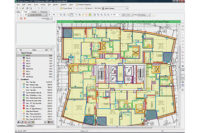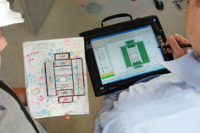Advantages of Building Green




Building green starts with the intention of the owner, then the designer, followed by the architect. It doesn’t stop there. Before electronic plans, subcontractors had little choice but to sift through mountains of project drawings to find something applicable and interesting to them. Construction automation changed the game in the 1990s and again in the mid-2000s.
Paper Vs. Electronic Plans
Electronic plans were introduced just prior to the 1990s, eliminating the need for paper plans. Construction professionals easily find their plans digitized, organized, catalogued, and synchronized by using plan rooms and online project centers. This step alone allows companies to be more socially responsible by minimizing paper waste. The electronic plans are easily loaded into the software, which results in huge savings by eliminating printing costs. A contractor no longer has to pay a print shop hundreds of dollars to print out plans for a job that they may not even win. Electronic plans do not have to be physically stored for future reference in a company’s warehouse; plans can reside on a server or computer hard drive for access years from now without any deterioration in quality.
Not only does this save time, it reduces the cost of distributing paper plans and specs across the project life-cycle. The ability to markup plans, complete the takeoff, and communicate the bid all electronically provides a process that is environmentally friendly. Being a part of building green isn’t a sacrifice when both time and money savings are recognized by multiple parties in the process. Building green begins with the commitment to do just that—from design, to plan, to build. The management of change orders through automation saves time and resources. An estimator no longer has to print multiple pages every time a change order is issued. Through automation, the changes are identified electronically, hence minimizing any oversight that can result in costly errors. Before automation, estimators spent hours looking over plans to identify changes. This digital process takes minutes.
Digital Project Management
The quantitative measurement and bid estimating processes went paperless long before the post-win project management process. Once onscreen takeoff eliminated paper plans, the project manager and foreman were buried in paper—binders of paper that the foreman used to manage the site. The foreman (the most valuable resource onsite) was now tied to a trailer, trapped in an office, or chained to a gang-box, sifting through paper.
The introduction of tablet technology in the mid-2000s is transforming field project management. The project manager and foreman are no longer stuck copying and sending papers back and forth regarding the project process or to clarify an aspect of the plans. Plans, change orders, RFIs, etc., are all sent electronically from the tablet in the field to the project manager’s laptop, wherever he/she might be.
In addition, with automation in the hands of the foreman at the job site location, when an issue arises there are fewer delays and improved steps to resolution.
This gradual shift toward accessing information wherever the contractor is located—whether in the office, the field, or somewhere in between—has resulted in an increased use of tablet technology at the job site. The use of tablet technology on the site saves time and improves communications. For example, a foreman or the project manager at the jobsite now has ready access to the latest set of plans, revisions and change orders. Likewise, cameras in tablets allow a foreman to easily document safety concerns or other issues that can hinder the job from getting completed on time. Such daily logs help contractors stay on budget and monitor and rectify obstacles that can cause lag time in a project. The tablet is the aluminum clipboard of the next generation—everything you need is right on that computer.
Green Technology
Building green is more than just eliminating paper, it also means finding ways to reduce material waste, create a better delivery process for materials, and a more accurate oversight of the crew. Construction technology and automation enables project managers to line out the workers, knowing how much material will be needed, and how long the work should take. Up-to-date stocking reports minimize the chance that excessive materials are ordered and/or delivered to the wrong area or floor.
Benefits of Building Green
Technology is rapidly changing the construction industry. From design, to build, to takeoff, construction companies are realizing the benefits that can be achieved by leveraging automation technology as a way to replace time-consuming and error-prone manual processes. The ability to boost efficiency and increase accuracy, build green, reduce waste, and increase profits are just some of the benefits technology offers.
All contractors are interested in reducing costs, saving time, and eliminating material waste and punch work items. Takeoff, estimating and project management automation result in these very benefits. Having come from the industry, I can say that using technology makes us more productive in the sense that we could double the volume of work we did in a year, or do more work during the day and get home at a reasonable hour.
Technology eliminates paper plans, paper faxing or mailing, as well as shows the exact work that should be done—when, where and how much material is needed. Building green and technology are not mutually exclusive, they are mutually beneficial.
Looking for a reprint of this article?
From high-res PDFs to custom plaques, order your copy today!






